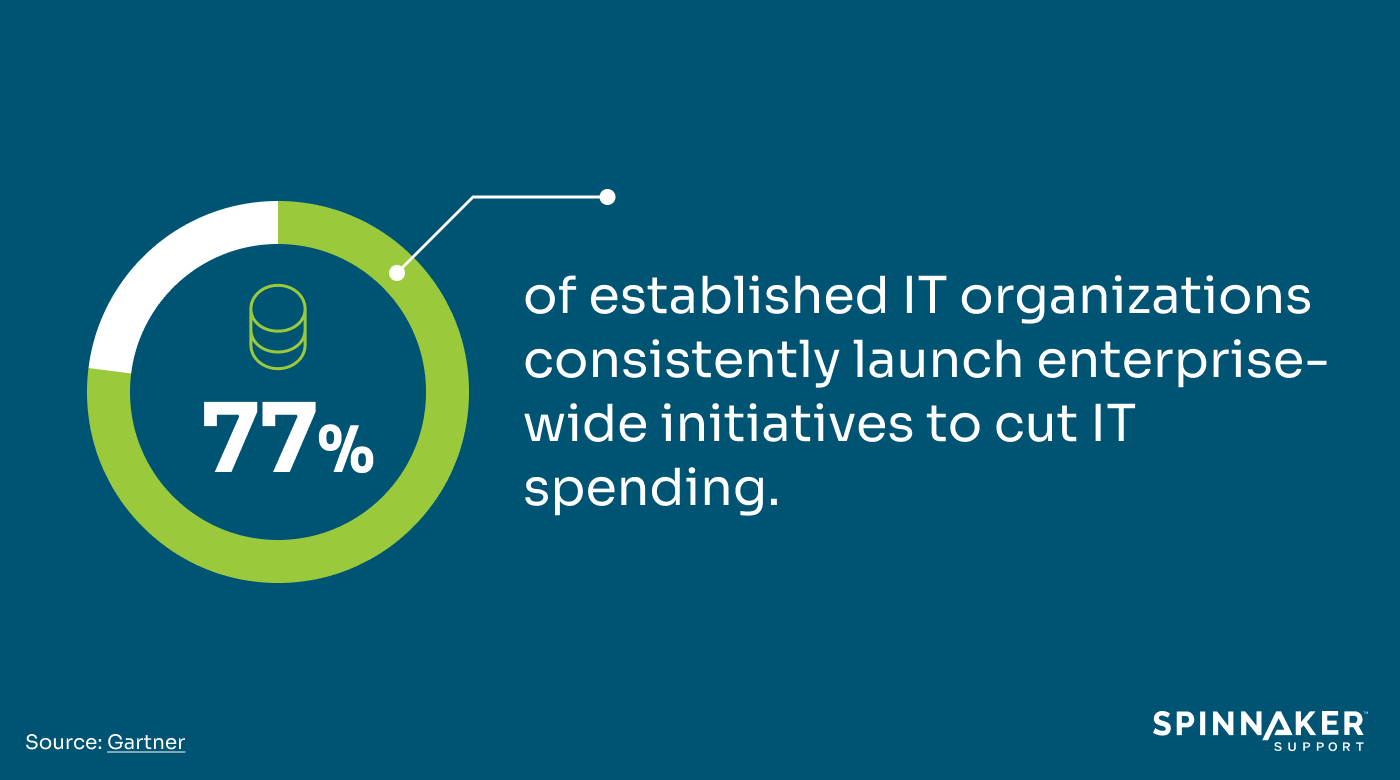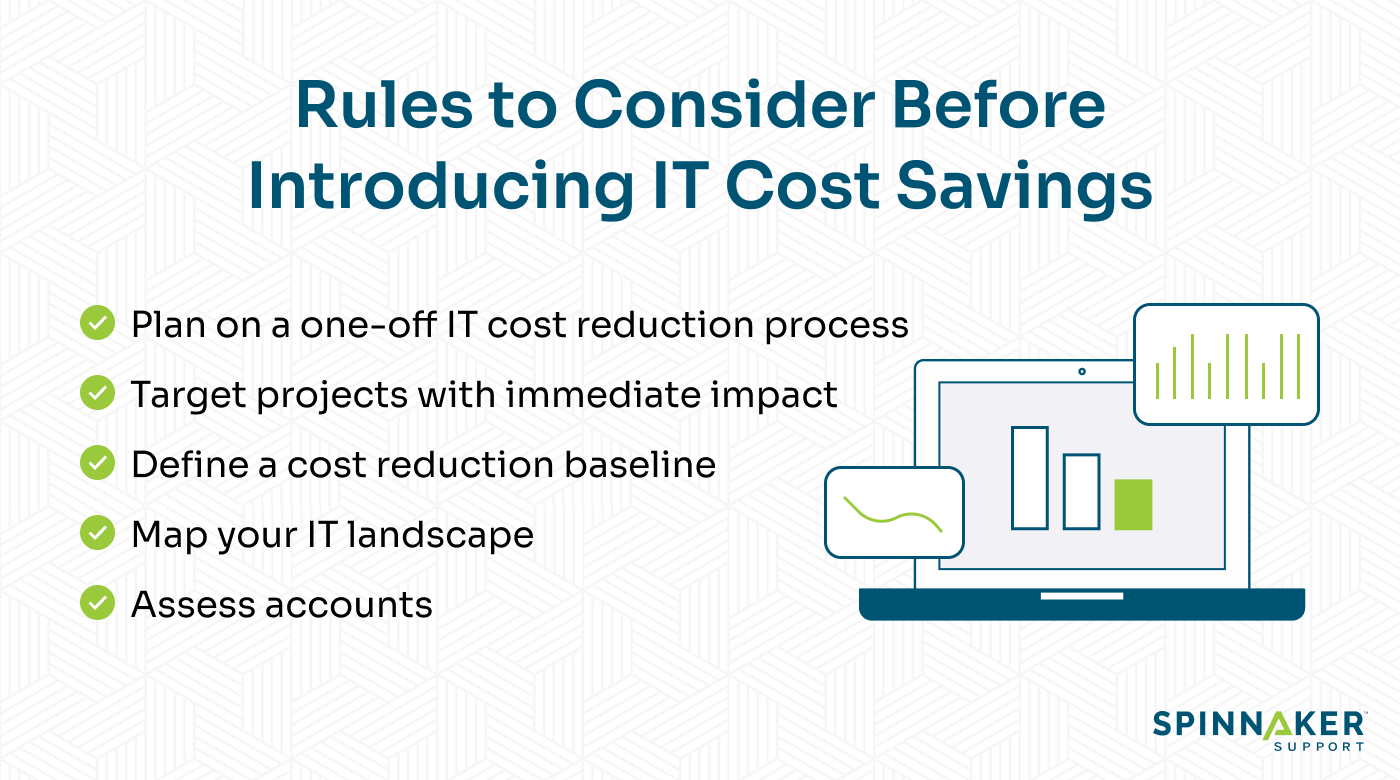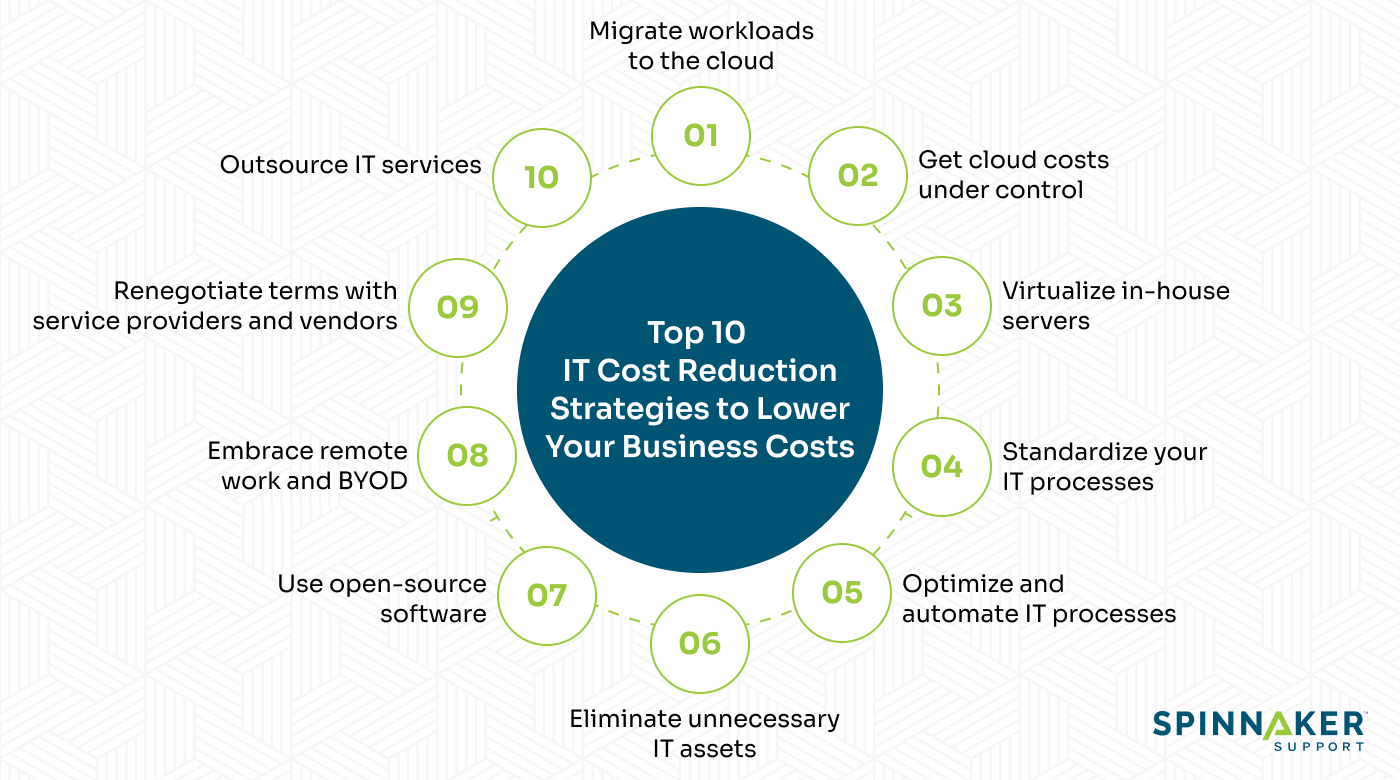Most businesses face the challenges of lowering IT costs and increasing organizational efficiency. Market fluctuations like inflation put pressure on organizations to make short-term cuts, but this must be done without disrupting operations.
You must plan every IT cost reduction measure carefully, or you risk damaging company performance and employee morale with unnecessary changes or overly drastic cuts.
This article will cover the most efficient IT cost-reduction strategies, including how third-party support providers like Spinnaker Support can help you achieve optimal cost savings.
What is IT cost reduction?
IT cost reduction refers to the measures taken to immediately reduce IT costs while causing the least possible disruption to day-to-day internal processes. This often occurs in the context of economic uncertainty and the drive to maintain profitability, which forces organizations to look for opportunities to reduce expenditures in a timely fashion.

IT cost reduction differs from long-term cost optimization. Long-term cost optimization involves continuously evaluating IT processes to reduce excess spending and eliminate waste. On the other hand, IT cost reduction is a quick way to save money and is typically implemented as a one-time measure to safeguard the company’s medium- to short-term health.
For example, it is possible to reduce costs by implementing strategies such as streamlining the existing IT infrastructure, utilizing software-as-a-service (SaaS) solutions, and outsourcing costly IT tasks to third-party service providers that offer more bang for your buck.
About 77% of established IT organizations consistently launch enterprise-wide initiatives to cut IT spending. Benefits of IT cost reduction include improved profitability, higher returns on technology investments, and an optimal spend-to-revenue balance.
However, you must make informed decisions about what and when to cut, or you risk doing more harm than good.
Rules to consider before introducing IT cost savings
Companies must set standards for governing IT cost reduction to ensure that they save money without sacrificing quality or productivity. Without proper strategies, IT cost reduction can create bottlenecks that damage business health and can reduce morale by exposing employees to layoffs and upended workflows.
For example, 60% of CFOs say they’ve dealt with wage inflation. But if staff reductions are implemented without effective workload management, it may result in burnout among the remaining employees.
So what rules should you consider before introducing IT cost savings?

Plan on a one-off IT cost reduction process
During your first round of cost reduction, it’s advisable to cut as many costs as possible in order to avoid repeating the process multiple times. Recurring IT cost reduction cycles can result in loss of productivity and uncertainty among your employees. Ensure you take enough time to strategize, plan, and execute a proper cost-reduction strategy. Do it right the first time.
Target projects with immediate impact
CIOs and IT architects should target projects with immediate and real cash impact. You can focus on costs that can truly be reduced or eliminated. For example, if you have hosted some workloads on the cloud, you can adjust resources based on demand by auto-scaling.
Define a cost reduction baseline
Knowing how much your current IT costs are is essential for setting a standard against which you can measure potential cost cuts. An excellent place to start is by looking at your current IT costs and identifying cost drivers. Additionally, you should involve key stakeholders to get everyone on the same page regarding the cost-cutting strategy’s objectives.
Map your IT landscape
It is important to catalog all of your assets to keep tabs on the efficiency and expense of your IT resources. Evaluate the utilization and performance of each asset. You can then assess the viability of alternative solutions, such as migrating specific workloads to the cloud. You can also look for ways to consolidate or renegotiate service contracts and software licenses.
Assess accounts
Audit all IT accounts and expenses, including fixed and variable costs, operating and capital expenses, and all idle assets and unspent budgets. This way, you can identify more affordable options for services or software without affecting functionality.
Top 10 IT cost reduction strategies to lower your business costs
Optimal IT cost reduction strategies can help your budget immediately as well as positively impact the bottom line in the long run. So, what are the top 10 IT cost reduction strategies?

1. Migrate workloads to the cloud
Most cloud providers use a pay-as-you-go system. Therefore, you can save money by paying only for the resources you actually use. You also stand to reduce the overhead associated with on-premise hardware, as you’ll no longer need to purchase expensive hardware and your IT team can spend less time on datacenter backups, patching, and other maintenance.
2. Get cloud costs under control
Assess your cloud infrastructure’s costs and architecture regularly. A surprising number of organizations find that when they look closely, they are overpaying on cloud spend for things like unused compute capacity or open instances that were not spun down when they should’ve been.
You can use auto-scaling to deactivate resources during periods of low activity, and, depending on your application’s requirements, you may be able to downsize to less expensive instance types and sizes.
3. Virtualize in-house servers
With virtualization, you can host numerous virtual servers on one physical server. Reducing the number of servers reduces hardware costs, power consumption, and data center space.
Virtualization allows servers to run at peak efficiency by dynamically allocating resources according to demand, preventing over-provisioning. This means less money spent on buying and maintaining hardware in the long run.
4. Standardize your IT processes
You can achieve cost savings through economies of scale when you purchase standardized IT resources and services. Do away with outliers and niche tools unless they’re truly necessary.
Standardization also helps long-term IT savings, as it is easier for your internal teams to maintain and support a consistent set of systems and processes. When IT departments learn to manage a standardized environment effectively, they will realize higher incident resolution rates.
5. Automate IT processes
The advent of AI has allowed modern systems to automate increasingly advanced IT tasks, including system backups, monitoring, and patch management. You can also automate resource allocation to dynamically adjust computing resources in response to demand. This saves money on idle capacity costs, avoids overprovisioning, and ensures that resources scale more closely with business needs.
Automation can also enhance or replace formerly manual tasks like customer support and data analysis. Around 54% of companies worldwide have reported that their service operations departments were able to reduce costs after implementing Artificial Intelligence (AI).
6. Eliminate unnecessary IT assets
When you map your IT landscape, you can observe which assets are idle or under-used. Most IT assets require overhead, such as hardware upkeep, software upgrades, and security patches. You can save money and time spent on maintenance by eliminating idle assets.
Additionally, you can shift your maintenance to a third-party support provider like Spinnaker Support, which can help you maintain your current stable versions and remove vendor-forced upgrades and patching.
7. Use open-source software
Another way to reduce IT expenses is by using free open-source software, which allows businesses to avoid the initial costs of buying software, as well as the expenses associated with vendor lock-in, such as recurring support fees. Open-source software also gives you room to customize and extend functionalities.
8. Embrace remote work and BYOD
Many IT tasks can be completed from anywhere with a web connection. Allowing your IT teams to work remotely can save on office-related costs like utilities, rent, office supplies, and so on.
Similarly, allowing employees to “Bring your own device” (BYOD) can reduce costs associated with the upkeep of company-owned IT assets – especially if you currently maintain a large pool of devices. Just make sure any BYOD devices are compatible with all the necessary apps and workflows, and that you’re still able to enforce security and compliance standards across the network.
9. Renegotiate terms with service providers and vendors
Another way to save IT costs is by renegotiating license and contract terms with vendors. You can discuss how any newer product releases could affect the services provided and the associated costs.
You may also need to review and change your Service Level Agreements (SLAs) to ensure they align with your ongoing business needs. Because of the strict requirements for vendor licenses and support fees, you may want to consider using third-party support as an alternative service provider.
For example, Stillwater Mining licensed Oracle’s eRecruit for expansion. However, this expansion required a switch from concurrent licensing to named user contracts. The licensing usage restructure forced JD Edwards EnterpriseOne (E1) support fees to increase six times. Stillwater Mining sought an alternative support option due to this significant cost increase.
Using Spinnaker Support services, Stillwater Mining’s customized fixes work better and faster. Stillwater Mining can also redirect IT funds to new integration and IT projects like OnBase.
10. Outsource IT services
Outsourcing IT services is among the most effective ways to cut costs. Third-party support providers can deliver top-tier services at a fraction of the cost of vendor support. Enterprises have realized an average of 62% savings when switching to Spinnaker Support.
At Spinnaker, you will work with engineers with over 20+ years of experience in your technology and application stacks, so you know your enterprise software is in good hands.
For example, although Autodesk paid a lot for SAP’s support, the company still did not receive updates or fixes to help it stay compliant. Therefore, Autodesk outsourced its application maintenance support to Spinnaker Support.
By delivering tailored patches for Autodesk’s SAP environment, Spinnaker helped drastically reduce the time it took to install and deploy service packs that SAP had previously delivered.
After using Spinnaker Support for a year, Autodesk has been able to re-invest the money they saved into other business-critical endeavors.
How third-party support can help you realize IT cost savings
Third-party support can save you a lot of money on yearly maintenance contracts, because they are typically able to provide premier levels of support at a lower price point than vendors. Because Spinnaker Support focuses exclusively on enterprise support, we can deliver white-glove service at a reasonable price.

Spinnaker lets you extend the life of your product for as long as you need by consolidating consultation, maintenance, and managed services under one reliable partner.
For example, Edinburgh Airport retained its current Oracle footprint as part of its recent massive IT infrastructure upgrade. However, the company needed an IT cost reduction strategy since Oracle was a substantial expenditure that was not producing a return on investment.
Edinburgh Airport sought a less expensive software maintenance and support strategy. They quickly realized Oracle would not negotiate new contract terms or cost savings.
Since joining Spinnaker Support in November 2016, Edinburgh Airport has saved over 60% on support fees. With the assistance of the Oracle experts at Spinnaker Support, Edinburgh Airport has improved numerous processes and operational efficiencies.
Additionally, Spinnaker can help you go into “sustain” mode on your on-premise applications as you plan your way forward. For instance, Wiginton Fire Systems started a JD Edwards upgrade project after Oracle stopped supporting its current release.
However, Wiginton switched to Microsoft Dynamics GP after multiple setbacks and higher upgrade costs. Wiginton contracted Spinnaker Support to maintain the software during the 18-month migration from JD Edwards applications.
This meant Wiginton could re-invest in other IT initiatives by cutting support spending, like implementing Global Software. Wiginton exemplifies how numerous JD Edwards clients use a combination of Spinnaker Support’s services to improve their operations collectively.
Conclusion
IT cost reduction is not an easy task, but if you approach it with care and knowledge, it can be achieved responsibly and effectively. One of the best places to start is by reconsidering your software maintenance and support contracts
Vendor support is a major expense for IT departments, but you can get third-party maintenance contracts for around half the price of vendor support, without sacrificing quality. Spinnaker Support offers personalized services to meet your unique business needs, including routine maintenance, break-fix services, and managed IT programs that allow you to completely offload chosen sectors of your IT offerings.
You can improve your company’s financial bottom line and gain control of operational expenses with the help of Spinnaker Support. If you are ready to leverage third-party support to actualize IT cost reduction, contact our IT support experts today.


